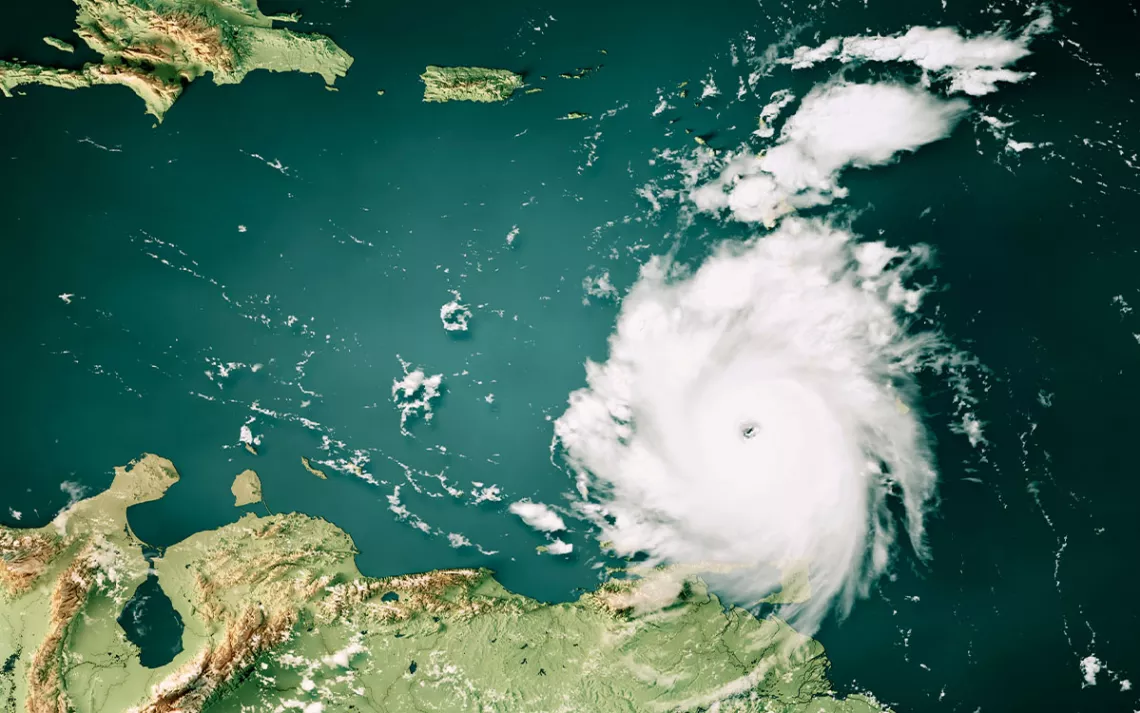What Would Happen to Science if the National Oceanic and Atmospheric Administration Were Broken Up?
Project 2025 proposes dismantling NOAA. Scientists and conservationists say the idea is “fraught with peril.”

Topographic map of the Caribbean Sea near the Lesser Antilles, courtesy of NOAA. The right-wing Project 2025 proposes dismantling the agency, which provides critical weather forecasting data to the public. | Illustration by FrankRamspott/Getty Images
When James Lindholm first heard about Project 2025’s proposal to dismantle the National Oceanic and Atmospheric Administration (NOAA), his first thought was that the idea, if realized, would be “fraught with peril.” Lindholm is a marine scientist at California State University, Monterey Bay, and a former NOAA employee. If NOAA were to vanish, he says, his life and the lives of millions of other Americans would become significantly more difficult.
The right-wing ideologues behind Project 2025, however, have a different perspective on the value of government-funded science. Project 2025 is a 900-plus-page document published by the conservative Heritage Foundation that is an encyclopedic wish list for a Far Right takeover of the federal government. Among its many other controversial provisions, Project 2025 calls NOAA a “colossal operation that has become one of the main drivers of the climate change alarm industry,” and then goes on to recommend that NOAA “be dismantled and many of its functions eliminated, sent to other agencies, privatized, or placed under the control of states and territories.”
So far, much of the media attention about Project 2025’s proposal to dismantle NOAA has focused on what this might mean for weather forecasting. Researchers like Lindholm say the impacts would stretch across a range of earth sciences.
NOAA was founded in 1970 under President Richard Nixon. Today, the nearly 55-year-old organization is split into six different sub-agencies that include the National Weather Service (NWS); the National Environmental Satellite, Data, and Information Service (NESDIS); the National Marine Fisheries Service (NMFS); the National Ocean Service (NOS); the Office of Oceanic and Atmospheric Research (OAR); and the Office of Marine and Aviation Operations (OMAO), inside of which are dozens of smaller offices. Together, these bureaus establish and disseminate data relevant to nearly every part of our lives, whether it's protecting the satellites that keep our phones running or guaranteeing the safety of the fish we eat.
“Literally every single person in the US relies on NOAA every single day,” says Jeff Watters, the vice president of external affairs for the Ocean Conservancy.
The Project 2025 blueprint proposes changes to all six sub-agencies. It argues for dissolving the Office of Marine and Aviation Operations while downsizing the Office of Oceanic and Atmospheric Research, the National Ocean Service, and the National Marine Fisheries Service and offloading many of their duties onto other departments or private companies. Project 2025 also imagines selling all of National Weather Service’s data to private companies and ensuring that National Environmental Satellite, Data, and Information Service only provides information “presented neutrally, without adjustments intended to support any one side in the climate debate.”
Rick Thoman, a climate specialist at the University of Alaska, Fairbanks, agrees that NOAA is not perfect. “It is an unnatural creation,” he says. “If you were designing this in a complete vacuum, it wouldn’t be the dumbest idea to not put fisheries in with the National Weather Service.”
Despite NOAA’s unwieldy structure, Thoman isn’t interested in taking the risk of private companies or other government branches taking its duties. Commercializing the National Weather Service, for example, would be bad news for his home state.
“If weather forecasts were completely privatized, this would be a complete disaster for Alaska,” he says. With its very small population, nearly 20 percent of whom are Indigenous, he says there is no way the State of Alaska would be able to afford privatized weather services for its whole landmass, which is more than 665,000 square miles. Alaska’s northern location makes it highly vulnerable to the effects of climate change: Deadhorse hit a record high 89°F on August 6 (its average temperatures at this time of year are in the 50s and 60s), and Juneau saw a nearly 16-foot glacial flood, the highest on record, the same day.
“The people that would not be able to pay for these weather services are the ones that need them the most,” Thoman says.
Watters argues that NOAA’s wide scope is actually a virtue, making it greater than the sum of its parts. “What makes NOAA special is the fact that it is an agency that combines weather and climate and the ocean, because those things all work in concert,” he says. “Breaking apart those pieces would massively weaken all three of them, because you can't understand or predict the weather without understanding climate and the ocean. You can't understand the ocean without understanding what's going on with the climate. And certainly you cannot understand the climate without understanding the ocean and its drivers in everything that happens across the globe.”
For Lindholm and his colleagues, NOAA’s offshore weather data is the go-to resource for planning research trips on the open ocean. If the swells are too high, going out on the water can be frustrating and even perilous.
“We’ve gotten our butts kicked offshore,” he says. “Without the information from NOAA, there would be a lot of failed data collection, a lot of wasted money, and possibly increased danger if we’re going out with less information.”

Sign up to receive Sierra News & Views
Get articles like this one sent directly to your inbox weekly.
With this action you affirm you want to receive Sierra Club communications and may vote on policy designated by the Sierra Club Board.
The risks go beyond NWS. Project 2025’s demand that NESDIS adjust its data to be “presented neutrally” poses the potential for data modifications or even outages. If outages were to occur during NOAA’s reorganization, which Thoman thinks would be impossible to avoid, it would have devastating consequences.
“You can't say ‘we're going to take the ocean data offline for six months.’ That would just break everything,” he says. “If you lost even 12 hours of input from satellites in the weather models, it would be a very bad thing.”
Lindholm, for his part, is more concerned with NOAA’s duties out on the ocean. Ocean regulation is already complicated: According to Lindholm, there are around 20 different federal agencies managing over 140 federal ocean statutes. He worries that removing NOAA would complicate things even further and weaken marine protections.
“I'm not convinced that anybody's ready to step into the void and offer the kind of holistic management that we need,” he says.
On a more conceptual note, Lindholm is concerned about what dismantling NOAA would do for his field. “I’ve been at this long enough to see a declining public investment in science,” he says. Lindholm, Thoman, and Watters have all benefited from NOAA, whether it was a job opportunity, data, or funding for their research. If all its branches experience significant downsizing, it’s possible funding for nongovernmental research will also decrease. In fields like marine and climate science that are becoming increasingly important, Lindholm says, losing already limited opportunities would be a massive blow.
Watters says the very nature of Project 2025’s attacks against NOAA—as much as the specifics of its proposals—are worrisome. Historically, NOAA has enjoyed bipartisan support from across the political spectrum. The fact that NOAA is now being framed as a “driver of the climate change alarm industry” concerns him.
“In a world where we depend on science, we want scientists to deliver us bad news, even if it doesn’t align with what someone wants to do politically,” he says. Breaking apart NOAA “is not going to stop climate change. It’s just a reaction to an agency that is telling us something we don’t want to hear.
“The notion that we would want to dismantle [NOAA] in a way that can hurt all of those services that we all depend on, and need honest scientific advice and knowledge from—that's deeply, deeply troubling.”
 The Magazine of The Sierra Club
The Magazine of The Sierra Club



